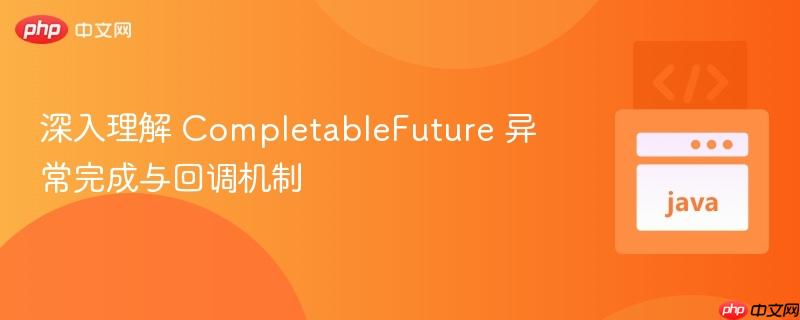
本文深入探讨了 completablefuture 在链式调用中处理异常完成的机制,重点阐述了 `whencomplete` 回调方法与 `completeexceptionally` 调用的正确关联。通过分析常见错误,揭示了 `completablefuture` 方法返回新实例的特性,并指导开发者如何正确引用并完成初始 future,确保回调逻辑按预期执行,从而避免回调不触发的问题。
Java 中的 CompletableFuture 提供了一种强大且灵活的方式来编写异步、非阻塞的代码。它支持链式调用,允许我们定义一系列的计算步骤,并在前一个步骤完成后执行后续操作。whenComplete 方法是其中一个常用的回调方法,用于在 CompletableFuture 完成(无论是正常完成还是异常完成)时执行一个动作。然而,在实际使用中,如果不理解 CompletableFuture 的链式调用如何创建新的 Future 实例,可能会导致回调不触发的困惑。
考虑以下代码片段,它尝试在 CompletableFuture 异常完成时打印一些信息:
import java.util.concurrent.*;
public class TestCompletableFuture {
public static void main(String[] args) throws Exception {
CompletableFuture<Void> future = new CompletableFuture<Void>()
.whenComplete((res, exc) -> {
System.out.println("inside handle.");
if (exc != null) {
System.out.println("exception.");
}
System.out.println("completed.");
}
);
future.completeExceptionally(new Exception("exception"));
System.out.println("finished.");
}
}执行上述代码,我们会发现控制台只输出了 finished.,而 whenComplete 中定义的任何打印语句都没有执行。这似乎与我们的直觉相悖,因为我们期望 completeExceptionally() 会触发 whenComplete() 中注册的回调。
这个问题的核心在于对 CompletableFuture 链式调用返回值的误解。像 whenComplete、thenApply、thenCompose 等方法,它们并不会修改当前的 CompletableFuture 实例,而是会返回一个新的 CompletableFuture 实例。这个新的实例代表了链中后续阶段的完成状态。
在原始代码中:
问题的关键在于,我们期望 whenComplete 监听的是被 completeExceptionally 完成的 Future。但在原始代码中,whenComplete 实际上是注册在第一个(匿名)CompletableFuture 实例上,而 completeExceptionally 却被调用在 whenComplete 返回的第二个 CompletableFuture 实例上。第一个实例从未被完成,因此其上注册的 whenComplete 回调也永远不会被触发。
为了确保 whenComplete 回调能够被触发,我们必须确保 completeExceptionally(或 complete)方法作用于注册了 whenComplete 回调的那个 CompletableFuture 实例。正确的做法是获取原始 CompletableFuture 的引用,并对其进行完成操作。
以下是修正后的代码示例:
import java.util.concurrent.*;
public class TestCompletableFuture {
public static void main(String[] args) throws Exception {
// 1. 获取原始 CompletableFuture 的引用
CompletableFuture<Void> initialFuture = new CompletableFuture<>();
// 2. 在原始 Future 上配置 whenComplete 回调,并获取返回的新 Future 实例
CompletableFuture<Void> chainedFuture = initialFuture
.whenComplete((res, exc) -> {
System.out.println("inside handle.");
if (exc != null) {
System.out.println("exception.");
}
System.out.println("completed.");
}
);
// 3. 对原始 Future 调用 completeExceptionally 来触发其完成
initialFuture.completeExceptionally(new Exception("exception"));
System.out.println("finished.");
// 检查两个 Future 的完成状态
System.out.println("initialFuture isDone: " + initialFuture.isDone());
System.out.println("chainedFuture isDone: " + chainedFuture.isDone());
System.out.println("initialFuture isCompletedExceptionally: " + initialFuture.isCompletedExceptionally());
System.out.println("chainedFuture isCompletedExceptionally: " + chainedFuture.isCompletedExceptionally());
}
}运行修正后的代码,输出将变为:
inside handle. exception. completed. finished. initialFuture isDone: true chainedFuture isDone: true initialFuture isCompletedExceptionally: true chainedFuture isCompletedExceptionally: true
现在,whenComplete 回调被正确地触发了。这是因为我们将 initialFuture 显式地完成了,而 chainedFuture 是 initialFuture 的一个下游阶段。当 initialFuture 完成时,它的完成状态(包括异常)会传递给 chainedFuture,从而触发 chainedFuture 上注册的回调。
同时,通过 isDone() 和 isCompletedExceptionally() 方法的输出,我们可以清楚地看到,当 initialFuture 异常完成时,chainedFuture 也随之异常完成。这表明 CompletableFuture 的链式结构会传播其完成状态。
通过深入理解 CompletableFuture 的链式调用机制和实例引用规则,开发者可以更有效地利用其异步编程能力,构建健壮且高效的并发应用程序。
以上就是深入理解 CompletableFuture 异常完成与回调机制的详细内容,更多请关注php中文网其它相关文章!

每个人都需要一台速度更快、更稳定的 PC。随着时间的推移,垃圾文件、旧注册表数据和不必要的后台进程会占用资源并降低性能。幸运的是,许多工具可以让 Windows 保持平稳运行。

Copyright 2014-2025 https://www.php.cn/ All Rights Reserved | php.cn | 湘ICP备2023035733号